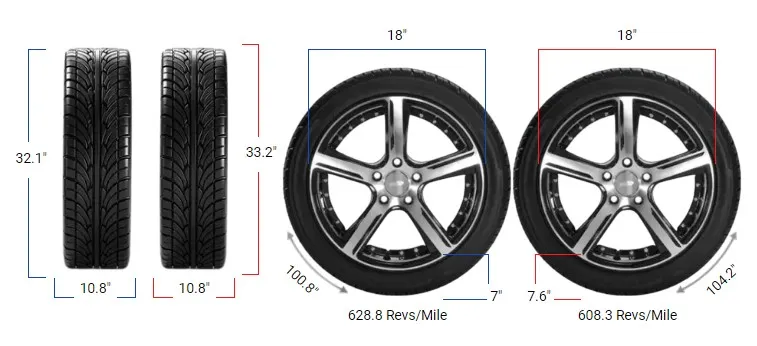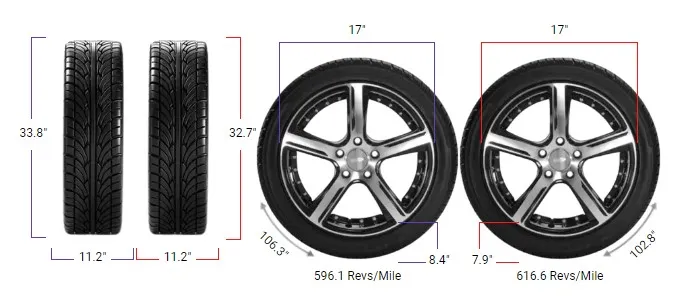265 vs 285 Tires

The number 265 or 285 in a tire’s size indicates its section width in millimeters. A 285 tire is 20 millimeters wider than a 265 tire, which means it provides a broader contact patch with the road.
This difference in width directly influences the handling, traction, and performance of the vehicle, depending on driving conditions.
The increased width of a 285 tire generally results in improved ground clearance, especially when paired with off-road adventures. If you’re looking for a bit more height and stability on uneven terrain, the 285 tires might be the better option.
In tire sizing, aspect ratio defines the height of the sidewall relative to its width. If you’re comparing 265 and 285 tires of the same aspect ratio and rim size, the difference primarily affects width rather than the sidewall height.
However, if the aspect ratios are different, this will also impact overall tire height, potentially influencing ride comfort and speedometer accuracy.
265 vs 285 Tires
Popular tire sizes are listed in the chart below, showcasing their overall diameter percentages and how interchangeable they are.
| Tire Pair | Difference | Interchangeable |
|---|---|---|
| 265/60r18 vs 285/60r18 | +3.10% | No |
| 265/70r17 vs 285/70r17 | +3.54% | No |
| 265/70r18 vs 285/65r18 | -0.05% | Yes |
| 265/75r16 vs 285/70r16 | +0.19% | Yes |
| 265/75r17 vs 285/70r17 | +0.18% | Yes |
| 265/80r17 vs 285/70r17 | -2.98% | Yes |
| 285/60r18 vs 265/65r17 | -2.86% | Yes, but rim sizes differ |
| 285/60r20 vs 265/70r17 | -5.58% | No, rim sizes differ |
| 285/70r17 vs 265/65r17 | -6.58% | No |
| 285/70r17 vs 265/70r17 | -3.42% | No |
| 285/70r17 vs 265/75r16 | -3.24% | No, rim sizes differ |
| 285/75r16 vs 265/70r16 | -6.81% | No |
| 285/75r16 vs 265/75r16 | -3.59% | No |
| 285/75r17 vs 265/70r17 | -6.61% | No |

Fitment Guide
The ideal rim width range for 265 tires is between 8.5 to 10.0 inches, while the range for 285 tires is between 9.5 to 11.0 inches.
There is an overlap in these ranges, specifically at 9.5 and 10.0 inches, meaning these rim widths can safely accommodate both tire sizes. If the aspect ratio and rim diameter are identical, switching between 265 and 285 tires becomes much simpler.
However, if there are differences in these parameters, you need to ensure that the overall diameter difference between the two tire sizes remains within 3%. This is to maintain proper performance, safety, and vehicle dynamics.

On-Road Performance
With a narrower width compared to 285 tires, 265 tires generally have lower rolling resistance, which can lead to better fuel efficiency.
They also tend to provide a more comfortable ride, especially on smooth roads, and can be more effective in rainy conditions due to less susceptibility to hydroplaning.
A wider tire like the 285 provides improved traction, particularly in dry conditions or during spirited driving. It also offers more stability, which is especially noticeable when cornering. However, this increased width can lead to more rolling resistance, potentially reducing gas mileage.
Off-Road Performance
265 tires are often preferred for mixed on- and off-road use, as they provide a good balance of traction and efficiency. The narrower footprint allows for better maneuverability in tighter spaces, which can be an advantage on narrow trails.
When off-roading, 285 tires have a larger footprint, offering better traction on loose or uneven surfaces. This makes them ideal for drivers who frequently encounter mud, sand, or rocky trails. The wider contact patch increases stability and reduces the risk of sinking into soft terrain.

Switching to 285 Tires
Pros:
- Increased Stability: The broader width provides a larger contact patch, improving stability, especially during cornering.
- Enhanced Traction: Wider tires deliver better traction, which is particularly beneficial for off-road or performance-oriented driving.
- Improved Aesthetics: Many drivers prefer the look of wider tires, as they give the vehicle a more aggressive and robust stance.
Cons:
- Reduced Fuel Efficiency: The larger width increases rolling resistance, which can lead to a noticeable decrease in fuel economy.
- Potential Rubbing Issues: Depending on your vehicle’s wheel well clearance, 285 tires may be more likely to rub, particularly during sharp turns or when the suspension is compressed.
- Higher Cost: Wider tires are often more expensive, both to purchase initially and to replace.
Staying with 265 Tires
Pros:
- Better Fuel Economy: With less rolling resistance, 265 tires typically yield better fuel efficiency, which can be significant for daily driving.
- Comfortable Ride: The narrower width allows for a more compliant sidewall, which can absorb road imperfections better, leading to a smoother ride.
- Reduced Risk of Hydroplaning: In wet conditions, narrower tires are less prone to hydroplaning, providing more control in the rain.
Cons:
- Less Traction: Compared to 285 tires, the narrower contact patch can provide less traction, particularly in off-road or high-performance situations.
- Less Aggressive Appearance: The narrower stance may not provide the aesthetic look that some drivers are seeking, particularly for off-road or lifted vehicles.

Difference Between 265 and 285 Tires
The key difference between 265 and 285 tires is their width. A 285 tire is 20 mm wider, which may improve handling and stability, especially off-road.
However, the 285 tire may slightly decrease fuel efficiency compared to the narrower 265 tire. Both tire sizes have overlapping ideal rim width ranges, making them compatible on certain rims. Ensure other factors like aspect ratio and diameter are considered before making the swap.
Can I Use 265 Tires Instead of 285?
Yes, you can use 265 tires instead of 285 as long as they fit the rim width range, which overlaps between both sizes.
Ensure that the aspect ratio and rim diameter are the same, or that the overall diameter difference is within 3%. Otherwise, it is not advisable to make the swap.
Can I Use 285 Tires Instead of 265?
Yes, you can use 285 tires instead of 265 if the rim width is within the overlapping range. The aspect ratio and rim diameter must also match, or the overall diameter difference must stay within 3%. If these conditions are not met, the swap is not recommended.

Can You Put 265 Tires on 285 Rims?
Yes, you can put 265 tires on rims designed for 285 tires as long as the rim width falls within the overlap of ideal width ranges.
Ensure other parameters like aspect ratio and diameter remain compatible to maintain safety and performance.
Can You Put 285 Tires on 265 Rims?
Yes, 285 tires can be mounted on rims that fit 265 tires if the rim width falls within the overlapping ideal range.
However, ensure that the aspect ratio and rim diameter match, or that the overall diameter difference is within the acceptable 3% limit to make the swap safe.
Our Observation
Choosing between 265 and 285 tires depends largely on your driving needs and priorities. If you prioritize fuel efficiency, a comfortable ride, and versatile on-road and off-road use, sticking with 265 tires is a sensible choice.
On the other hand, if you want increased traction, stability, and an aggressive look—particularly if you do a lot of off-road driving—the 285 tires are the better option.
Always ensure that your rim width range and overall diameter considerations are in line before making the switch.



